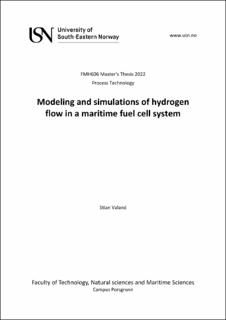| dc.description.abstract | The climate change challenge is one of today's greatest challenges, and the need to reduce emissions is more significant than ever. Hydrogen can be a potential zero-carbon fuel, and together with a maritime fuel cell system, there is a great potential to reduce emissions from the maritime sector.
As hydrogen has a very low energy density per volume, there are mainly two ways of utilizing hydrogen as a fuel. Either by liquefying- or by compressing the gas. This study is primarily focused on a compressed gas system. The main aim of this study is to develop a transient numerical model of a fuel cell supply system. But the study will also consider a general literature review on fuel gas supply systems, a simple design proposal of a hydrogen fuel supply system, and a review of equations of state relevant to the numerical model.
There is yet no specific complete framework published covering the design of maritime fuel cell systems. According to DNV, the IGF-Code is the most representable standard to be used as guidelines. The IGF-Code does not consider piping for hydrogen gas, which the standard ASME B31.12 does, however, not from a maritime perspective. Therefore, a simple strength calculation considering the fuel supply pipelines for a “base case” vessel has been performed with both the IGF-Code and the ASME B31.12-2011. The results indicate that the IGF-Code has a more conservative approach for design pressures up to 53 MPa, while ASME B31.12-2011 is found to be the most conservative standard for pressures above 53 MPa.
The one-dimensional dynamic leak flow model has been developed by implementing a finite difference 2nd-order accurate centered FLIC scheme for solving the set of non-linear hyperbolic governing equations. The model considers the effects of friction, minor losses, and heat losses, which are implemented as source terms by source-terms splitting. Modeling of the leakage flow has been performed using isentropic relations and the assumption of sonic flow through the leakage orifice. Two flux limiters, Superbee and Minbee, were implemented. Superbee showed an oscillatory tendency, probably caused by the implemented source terms. The Minbee limiter showed stable behavior but is said to be more diffusive. The simple and well-performing Abel-Noble EOS has been implemented in the model, but the design pressure in this study is 10 bar, and the results from the simulations indicate that the ideal gas law would have been a sufficient choice.
The results obtained from the dynamic leak flow model indicate that the pressure drop from the rarefaction wave is larger downstream of the leak location than the same distance from the leakage location upstream. This is identified to occur due to the implemented source terms in the model. If the ratio between the leak orifice diameter and the pipe diameter exceeds 0.2, the calculated leakage mass flow rate is larger than the calculated inlet mass flow in the pipeline. This is probably possible initially as the pipeline’s volume is filled with hydrogen, and the leaking hydrogen can come from both downstream and upstream of the point of leakage. The implemented dynamic leak flow model seems to estimate reasonable results for the pipeline gas flow and leakage. | |
